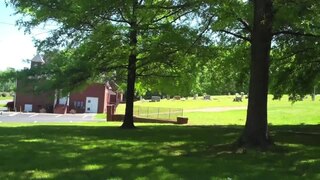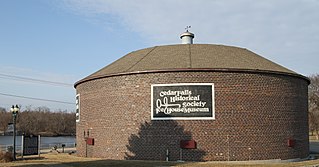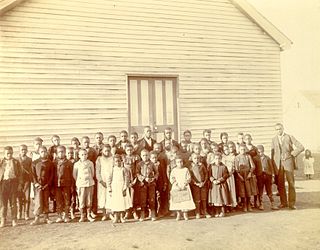
Natural Bridge is a geological formation in Rockbridge County, Virginia, United States, comprising a 215-foot-high (66 m) natural arch with a span of 90 feet (27 m). It is situated within a gorge carved from the surrounding mountainous limestone terrain by Cedar Creek, a small tributary of the James River. Consisting of horizontal limestone strata, Natural Bridge is the remains of the roof of a cave or tunnel through which the Cedar Creek once flowed.

The Rosenwald School project built more than 5,000 schools, shops, and teacher homes in the United States primarily for the education of African-American children in the South during the early 20th century. The project was the product of the partnership of Julius Rosenwald, a Jewish-American clothier who became part-owner and president of Sears, Roebuck and Company and the African-American leader, educator, and philanthropist Booker T. Washington, who was president of the Tuskegee Institute.

The Emory School, also known as the Tunstall School, is a historic Rosenwald School building in rural Hale County, Alabama, United States. It was built in 1915 to the designs of W.A. Hazel to serve the local African American community. The money to build the school was provided by the Julius Rosenwald Fund. The school was listed on the National Register of Historic Places on February 20, 1998, as a part of The Rosenwald School Building Fund and Associated Buildings Multiple Property Submission.

The Oak Grove School is a historic Rosenwald School building in rural Hale County, Alabama, United States. It was built to the designs of Samuel Smith in 1925 to serve the local African American community. The money to build the school was provided by the Julius Rosenwald Fund. The school was listed on the National Register of Historic Places on March 3, 1998, as a part of The Rosenwald School Building Fund and Associated Buildings Multiple Property Submission.

The Tankersley Rosenwald School, also known as the Tankersley Elementary School, is a historic American Craftsman-style school building in Hope Hull, Alabama, a suburb of Montgomery. This Rosenwald School building was built in 1922 to serve the local African American community. The money to build the school was provided, in part, by the Julius Rosenwald Fund. It was added to the Alabama Register of Landmarks and Heritage on June 26, 2003, and to the National Register of Historic Places as a part of The Rosenwald School Building Fund and Associated Buildings Multiple Property Submission on January 22, 2009.

The Cedar Falls Ice House is a historic building located in Cedar Falls, Iowa, United States. It was built in 1921 and has been listed on the National Register of Historic Places since 1977. The building currently serves as the Ice House Museum.

Cadentown School in Lexington, Kentucky was a primary public school for black children in the segregated Fayette County Public Schools from about 1879 to 1922. The building that originally housed Cadentown School, located at 705 Caden Lane, is no longer extant. However, the Rosenwald Fund School is listed on the National Register of Historic Places in Fayette County.

The Chicot County Training School was a historic school building at the corner of Hazel and North School Streets in Dermott, Arkansas. The single story H-shaped building was built in 1929 with funding support from the Rosenwald Fund, a major philanthropic effort to improve educational opportunities for African-Americans. The school was preceded by Dermott Baptist Industrial School, co-founded by Isaac George Bailey, and then Morris Booker High School and Memorial College. It was succeeded by Morris Booker Memorial College. The building was listed on the National Register of Historic Places in 2004. The school building collapsed and burned after being abandoned. It was delisted from the National Register in 2022.

Pine Grove Rosenwald School, also known as Pine Grove Colored School, is a historic Rosenwald school building located at St. Andrews, Richland County, South Carolina. It was built in 1923, and is a one-story, rectangular gable-front frame building. Its layout is a variant of the two-room schoolhouse and features large banks of tall narrow windows.

The Catawba Rosenwald School is a historic school building at 3071 South Anderson Road United States Route 21) in Catawba, South Carolina. It is a single-story wood-frame structure, built in 1924–25 with support from the Rosenwald Fund, to one of the fund's architectural plans. It served as a school for the area's African-American population from then until its closure in 1956. In 1960 the vacant building was moved within the same property to accommodate the widening of South Anderson Road. It is one of two surviving Rosenwald schools in York County. It is owned by the Rock Hill School District.

The Oak Grove Rosenwald School is a historic school building on Oak Grove Road in Oak Grove, a small settlement in southeastern Sevier County, Arkansas. It is a single-story wood-frame structure, built in 1926 with financial assistance from the Rosenwald Fund. It has two classrooms, and is based on a standard plan developed by Samuel Smith, an agent for the Rosenwald Fund, for this type of small community school. It was probably used for the education of local African Americans until the state's schools were integrated, and is the only surviving Rosenwald school in the county.

The Marley Neck Rosenwald School is a historic school building located at 7780 Solley Road in Glen Burnie, Maryland. It is a single story wood-frame structure measuring 68 by 20 feet, with a gable roof. The school was built in 1927 with design and funding assistance from the Rosenwald Fund, and served the area's African-American students. Out of the original twenty three built, it is one of the ten surviving Rosenwald schools in the county.

Reid's Grove School is a historic Rosenwald school located near Gatesville, Gates County, North Carolina. It was built in 1927, and is a one-story, side-gable frame school with a prominent projecting single-bay gabled wing. It was one of seven schools in the county financed and constructed with the assistance of the Rosenwald Fund for the education of African-American children. It replaced an earlier school built in the 1880s. The building ceased its function as a school in 1951.

The Cedar Grove School #81 is a historic school building on the west side of Arkansas Highway 115 in the small community of Brockett, Arkansas, about 5 miles (8.0 km) north of Pocahontas. It is a wood frame one-room schoolhouse, 23 by 41 feet in size, with a gable roof and a concrete foundation. It was built in 1938, replacing another building destroyed by a tornado, and served as a district school until 1948, when the district was consolidated into the Pocahontas schools. The building has been used since then by the Brockett Home Extension Club as a community center.

Hopewell School, also known as the Hopewell-Rosenwald School, is a former African American school in Cedar Creek, Texas, that was listed on the National Register of Historic Places on July 15, 2015. The school was built in 1921–1922 with assistance from the Rosenwald Fund. The school opened in 1922 and closed in the late 1950s.

Mays Lick Negro School is a former black school in May's Lick, Kentucky. The schoolhouse, which dates to the 1920s, has been declared a historic landmark. It was a Rosenwald School.

A two-room schoolhouse is a larger version of the one-room schoolhouse, with many of the same characteristics, providing the facility for primary and secondary education in a small community or rural area. While providing the same function as a contemporary primary school or secondary school building, a small multi-room school house is more similar to a one-room schoolhouse, both being architecturally very simple structures. While once very common in rural areas of many countries, one and two-room schools have largely been replaced although some are still operating. Having a second classroom allowed for two teachers to operate at the school, serving a larger number of schoolchildren and/or more grade levels. Architecturally, they could be slightly more complex, but were still usually very simple. In some areas, a two-room school indicated the village or town was more prosperous.

The Cedar Grove School is a historic one-room schoolhouse located at 4216 County Route 516 in Old Bridge Township of Middlesex County, New Jersey, United States. Built in 1885, it was added to the National Register of Historic Places on October 24, 1976 for its significance in education and community history. It was named after the nearby cedar trees and cedar swamp. Since 1964, the building has been the Thomas Warne Museum, run by the Madison–Old Bridge Township Historical Society.




















